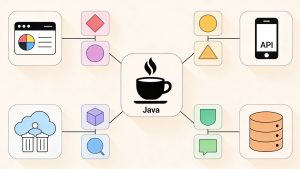
Databases are at the heart of nearly every software application. Whether you’re building a social media platform, an e-commerce store, or a financial system, the need to store, access, and modify data is universal. At the core of these interactions lies CRUD which is short for Create, Read, Update, Delete.
Understanding CRUD is crucial for developers, testers, and architects alike. It simplifies communication between teams (“we just need a CRUD API for users”), enforces consistency in system design, and provides a clear mental model for handling data across any application. Whether you’re just starting out with SQL queries or building scalable microservices, CRUD is the common thread that ties all of software engineering together.
In this guide, we’ll break down CRUD operations with examples across multiple programming languages, explore their role in REST APIs and user interfaces, highlight their benefits and limitations, and wrap up with best practices for implementing CRUD in real-world applications.
Introduction to CRUD
CRUD defines the four basic functions of persistent storage:
- Create – Add new data into the system (e.g., registering a user).
- Read – Retrieve existing data (e.g., viewing a profile).
- Update – Modify existing data (e.g., editing an email address).
- Delete – Remove data (e.g., deleting an account).
These operations map directly to database commands and are the foundation of both relational (SQL) and non-relational (NoSQL) databases.
CRUD Operations Explained
1. Create
Adding new records to a database.
SQL Example:
INSERT INTO users (id, name, email)
VALUES (1, 'Alice', 'alice@example.com');Python Example (SQLite):
import sqlite3
conn = sqlite3.connect("app.db")
cursor = conn.cursor()
cursor.execute("INSERT INTO users (name, email) VALUES (?, ?)", ("Alice", "alice@example.com"))
conn.commit()JavaScript (Node.js + MongoDB):
const { MongoClient } = require("mongodb");
async function run() {
const client = new MongoClient("mongodb://localhost:27017");
await client.connect();
const db = client.db("app");
await db.collection("users").insertOne({ name: "Alice", email: "alice@example.com" });
console.log("User created");
}
run();2. Read
Fetching data from a database.
SQL Example:
SELECT * FROM users WHERE id = 1;Python Example:
cursor.execute("SELECT * FROM users WHERE id=?", (1,))
print(cursor.fetchone())Java Example (JDBC):
ResultSet rs = stmt.executeQuery("SELECT * FROM users WHERE id=1");
while(rs.next()){
System.out.println(rs.getString("name") + " - " + rs.getString("email"));
}3. Update
Modifying existing data.
SQL Example:
UPDATE users SET email = 'alice.new@example.com' WHERE id = 1;- JavaScript Example (Express + MongoDB):
app.put("/users/:id", async (req, res) => {
const { id } = req.params;
const { email } = req.body;
await db.collection("users").updateOne({ _id: id }, { $set: { email } });
res.send("User updated");
});4. Delete
Removing data permanently.
SQL Example:
DELETE FROM users WHERE id = 1;Python Example:
cursor.execute("DELETE FROM users WHERE id=?", (1,))
conn.commit()Java Example:
stmt.executeUpdate("DELETE FROM users WHERE id=1");CRUD in REST APIs
CRUD maps naturally to HTTP methods in RESTful APIs:
Create – POST
POST /users
{
"name": "Alice",
"email": "alice@example.com"
}Read – GET
GET /users/1Update – PUT/PATCH
PUT /users/1
{
"email": "alice.new@example.com"
}Delete- DELETE
DELETE /users/1This alignment makes CRUD an intuitive model for designing APIs.
CRUD in User Interfaces
End-users interact with CRUD daily without realizing it. Examples include:
- Create– Sign-up forms.
- Read– Search results or profile views.
- Update– Editing a shopping cart or account details.
- Delete– Removing an item from favorites or deleting a post.
Frontends (React, Angular, Vue) usually send CRUD requests to a backend API, which then communicates with a database.
React Example (Calling a CRUD API):
// Fetch user details
useEffect(() => {
fetch("/users/1")
.then(res => res.json())
.then(data => setUser(data));
}, []);Benefits of CRUD Model
- Simplicity – Easy to understand and implement.
- Consistency – Standardized operations across applications.
- Scalability – Can be applied to relational, NoSQL, or file-based systems.
- Reusability – Same CRUD principles apply across APIs, databases, and UIs.
Limitations of CRUD
- Over-simplification – Not all business processes map neatly to CRUD.
- Security concerns – CRUD endpoints, if unprotected, may expose sensitive data.
- Scalability issues – Bulk operations or analytics often require more complex queries.
- Soft deletes vs hard deletes – Removing data permanently can be risky.
CRUD Across Different Systems
- Relational Databases (SQL) → MySQL, PostgreSQL, Oracle.
- NoSQL Databases → MongoDB, DynamoDB, CouchDB.
- File Systems → Creating, reading, updating, deleting files.
- Cloud Services → AWS S3 operations align with CRUD (PUT, GET, DELETE).
Example with AWS S3 (CRUD on files):
import boto3
s3 = boto3.client("s3")
# Create/Upload
s3.upload_file("local.txt", "my-bucket", "remote.txt")
# Read/Download
s3.download_file("my-bucket", "remote.txt", "downloaded.txt")
# Update (overwrite)
s3.upload_file("updated.txt", "my-bucket", "remote.txt")
# Delete
s3.delete_object(Bucket="my-bucket", Key="remote.txt")Best Practices for Implementing CRUD
- Validate Inputs – Prevent SQL Injection and invalid data.
- Use Parameterized Queries – Always bind variables securely.
- Implement Pagination – Avoid fetching all records at once.
- Use Soft Deletes – Mark records as inactive instead of deleting permanently.
- Add Authentication/Authorization – Restrict CRUD actions to permitted users.
- Error Handling – Always return meaningful error messages.
- Logging & Auditing – Track changes for accountability.
Conclusion
CRUD is more than just an acronym. It is the backbone of data management in modern software systems. Whether you’re designing a small web app or building enterprise-scale platforms, every interaction with data boils down to Create, Read, Update, and Delete. These four operations form the foundation of how applications communicate with databases, power APIs, and deliver seamless user experiences.
From a backend perspective, CRUD ensures that databases remain consistent and predictable. SQL queries like INSERT, SELECT, UPDATE, and DELETE give developers precise control over structured data, while NoSQL databases like MongoDB expose similar capabilities through document-oriented commands. On the frontend, CRUD powers interactive user interfaces when users sign up, edit profiles, search products, or remove items from a cart, they’re unknowingly executing CRUD operations in the background. And in cloud-native systems, CRUD translates into RESTful API endpoints, GraphQL mutations, or serverless functions that keep distributed architectures cohesive.
The real strength of CRUD lies in its universality. It provides a common vocabulary for developers, QA engineers, architects, and even business stakeholders. When a team says, “We need CRUD functionality for customers,” everyone instantly knows what that means. It means no technical ambiguity, just clarity. This universality extends across technologies: Python’s Django ORM, Node.js with Express, Java’s JPA/Hibernate, or even AWS DynamoDB and Firebase all expose CRUD patterns in their own way, reinforcing its role as the universal language of data.
By internalizing CRUD and applying these best practices, developers can go beyond just “making it work” to creating applications that scale gracefully, withstand failures, and protect sensitive data.
In the end, CRUD is not just a developer’s tool but a mindset for thinking about data interactions across the software stack. Whether you’re writing SQL queries, crafting RESTful endpoints, designing a UI, or deploying to the cloud, CRUD operations will always be at the center of your work. The more deeply you understand them, the better equipped you’ll be to design systems that are clean, efficient, and future-proof.



